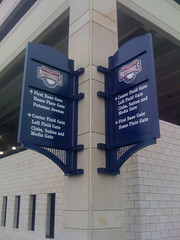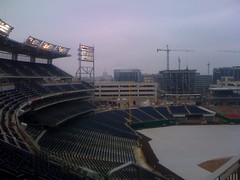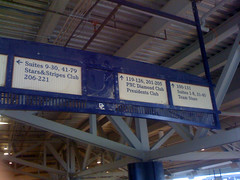 This weekend, as part of the Super Flush, I got an excellent tour of the new stadium under construction. Nationals Park (which I hope it remains) is truly a wonder to behold. The concrete and glass exterior was the part I was most concerned about when the initial HOK designs were released. I was worried that it wouldn’t look as good as Oriole Park in its red-brick, or any of the other new stadiums that have been built over the past couple years, as when I think cast concrete, I think of any of the various ugly ass buildings downtown that have all the personality of a washed-up tax accountant. Nationals Park has found a way, though, to make concrete sexy in a way that I didn’t think was possible.
This weekend, as part of the Super Flush, I got an excellent tour of the new stadium under construction. Nationals Park (which I hope it remains) is truly a wonder to behold. The concrete and glass exterior was the part I was most concerned about when the initial HOK designs were released. I was worried that it wouldn’t look as good as Oriole Park in its red-brick, or any of the other new stadiums that have been built over the past couple years, as when I think cast concrete, I think of any of the various ugly ass buildings downtown that have all the personality of a washed-up tax accountant. Nationals Park has found a way, though, to make concrete sexy in a way that I didn’t think was possible.
We were led around the insides of the stadium, and the aura is of a still unfinished construction site, with building materials crowding the halls and various craftsmen hard at work on all the details. The seats are in place, the main structures complete and the scoreboard up and lit for all to see. The dugouts and locker rooms are very near completion, and the stadium’s plumbing is, as of this weekend greenlit. The beer lines are in and all lead down to the two condo-sized beer coolers that will pipe icy-cold deliciousness to taps throughout the stadium. And, as of this afternoon, you can enjoy a nice half-smoke from the Ben’s Chili Bowl stand that’s going into the stadium. No word on which labels will be on the tap handles just yet, though.
This post appeared in its original form at DC Metblogs
 After a tour of the bowels of the stadium, it was out to the field itself. The hallway to the ballpark is a holy place at any stadium. The feeling of walking out onto the field at any stadium is that boundary at which all good things happen. In my score of the Brahms Deutsches Requiem, I have written at the top of Movement IV, “Like the hallway leading to a ballfield.” And that’s the song I heard in my head on Saturday as we made our way into the winter chill. It didn’t matter it was only 35°F out there. It was 70 and sunny in my mind. The sky was not the dour overcast neutral grey, it was a rich blue hue, with white puffy clouds and the sun felt like the touch of angels.
After a tour of the bowels of the stadium, it was out to the field itself. The hallway to the ballpark is a holy place at any stadium. The feeling of walking out onto the field at any stadium is that boundary at which all good things happen. In my score of the Brahms Deutsches Requiem, I have written at the top of Movement IV, “Like the hallway leading to a ballfield.” And that’s the song I heard in my head on Saturday as we made our way into the winter chill. It didn’t matter it was only 35°F out there. It was 70 and sunny in my mind. The sky was not the dour overcast neutral grey, it was a rich blue hue, with white puffy clouds and the sun felt like the touch of angels.
That’s how it felt to walk out into the stadium for the first time. It’s a feeling I love at every stadium I’ve been to, but this time felt more special. It’s ours. For keeps.
Kinsella wrote that empty ballparks feel more like a church than most churches, and I certainly felt that way as we walked along the first baseline. There’s a holy, eerie quiet around an empty ballpark that was present at Nationals Park, despite the on-going construction. There were workman everywhere throughout the concourse and the various luxury-suite clubs that will dominate the area behind the seats at the homeplate and second concourse levels, but the ballpark felt right. The scoreboard is brilliant in right field, featuring the largest HD monitor in the western world, and a large bold sans-serifed logo for Nationals Park to go along side the curly W clock that is the dominant feature in the outfield.
 There’s a lot to look at, image-wise, in the choices the Nationals have made for the signage. This concourse sign is a great example. If you look at the detail work beneath the sign itself, you’ll see a gentle arched/lined pattern that I tend to associate with suspension bridges, but looks oddly like the Yankee Stadium “Treble Arch” Logo. You can see the exterior sign version shares that motif as well.
There’s a lot to look at, image-wise, in the choices the Nationals have made for the signage. This concourse sign is a great example. If you look at the detail work beneath the sign itself, you’ll see a gentle arched/lined pattern that I tend to associate with suspension bridges, but looks oddly like the Yankee Stadium “Treble Arch” Logo. You can see the exterior sign version shares that motif as well.
I’d love to read the style guide that they devised for the various signage, as well. Most of the main concourse signs are royal blue on a parchment background with a blue pinstripe, which also evokes images of the most famous franchise on the planet. No other baseball brand is so closely associated with the pinstripe motif than the Yankees, and one might suggest that to approach the pinstripe as part of an attempt to rebrand yourself might be the kind of hubris that gets your karma in trouble.
One thing I found frustrating was how much of the park would be off-limits to many of the casual attendees. The luxury clubs behind home plate at field level and 200 level are separated from the rest of the stadium by doors that will likely be watched by ushers who will keep the riff-raff (ie, ME) from going anywhere near these exclusive clubs. Membership in most of these places is going to set you back the cost of a suite each year, which is definitely upwards of a hundred large. For that price, there had better be happy endings, if you know what I mean.
For those who are spending $325 a seat for the area behind home plate, or those spending $175 a seat for the seats immediately behind those, opulence awaits you. The posh digs in the Presidents’ Club and PNC Diamond Club are pretty amazing. Beautiful Mahogany and Cherry wood bars and accents, plush leather couches and 60″ Plasma screens, plus the nicest of the bars in the stadium will likely await all those lobbyists who will fork over the bones to be there.
Me, I’ll be up in 319 for my twenty games, but the view from my seat will keep me happy, and then less I think about the ludicrous extravagance provided to the ultra-rich who are recipients of the city’s corporate welfare, the better.
Bring on Opening Day!
This post appeared in its original form at DC Metblogs


